Speech Investment and the Australian Economy

Philip Lowe
[*]
Deputy Governor
Address to the CFA Australia Investment Conference
Melbourne –
- Audio 23.98MB
- Q&A Transcript
I would like to thank the CFA Institute and CFA Societies Australia for the invitation to speak this afternoon.
I would also like to acknowledge the work that the CFA and its members have done in promoting the integrity of capital markets and the provision of ethical investment advice. Over recent years we have seen too many ethical lapses in the global financial services industry and the bonds of trust between investors and institutions have been strained. Strengthening these bonds is critical to the financial services sector playing its important role in promoting a strong and vibrant global economy. I wish you all the best in pursuing this important task.
Confidence is also, of course, an important factor influencing business decisions to invest and to expand. Indeed, a lack of confidence has been one of the factors holding back investment in many countries over recent years. So given that this is the CFA's Australia Investment Conference, I thought it appropriate to focus my remarks today on the topic of investment. I would first like to spend time discussing recent investment trends in Australia, particularly the investment outcomes in the non-mining sector. I would then like to look forward and discuss what the outlook might hold.
Recent Developments
It is worth starting off with the global context.
As you are no doubt aware, over recent years the Australian economy has performed much better than the economies of most other developed countries. We avoided a recession during the global financial crisis, although growth has been below average recently. Our banks have remained sound. Public debt levels are comparatively low. The Reserve Bank has not had to expand its balance sheet massively. And inflation has been close to target. Very few other countries can make such claims.
But my focus today is the story on investment.
Since 2008, the developed economies have been in an investment drought. Indeed, the four years from 2008 to 2012 saw the lowest level of investment, relative to GDP, in the developed economies for many decades (Graph 1). For the world as a whole, investment has also been very low.
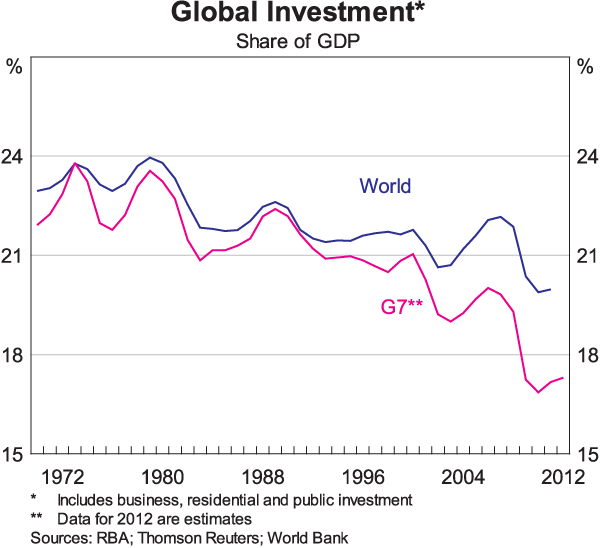
In Australia, the investment picture is very different. Rather than experiencing an investment drought, we have had an investment boom, particularly in the private sector. Recently, business investment peaked at over 18 per cent of GDP, its highest level in more than 50 years (Graph 2). And the nation's overall capital stock (including both private and public capital) has been expanding at around 5 per cent per annum, the fastest rate of increase since the early 1970s. In contrast, in some other developed economies, the level of investment has barely been enough to offset the depreciation of the existing capital stock.
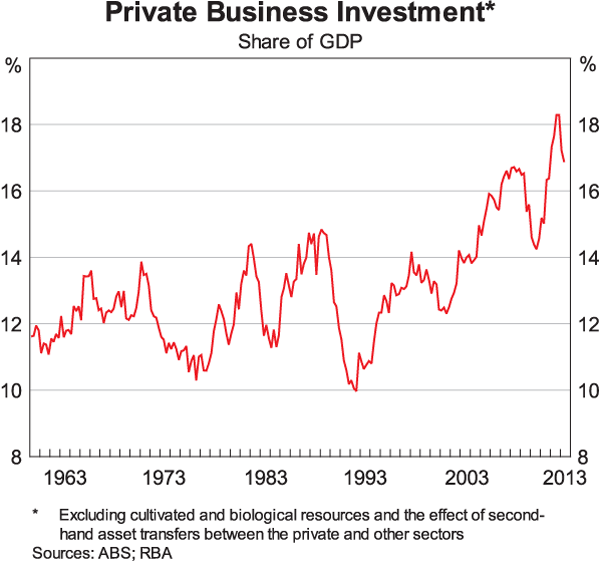
The reasons for this difference are well understood. Most of the advanced economies have been dealing with the fallout of the severe banking and debt problems of the late 2000s. In contrast, we avoided these problems and have been benefiting from the growth in Asia. This growth has pushed up the prices of many commodities, which has encouraged investment in the extraction of Australia's natural resources, particularly iron ore, coal and natural gas. This investment has boosted our resource exports, and will provide an important source of national income for many years to come.
This aggregate picture, however, hides some large differences across sectors. Mining investment has been extraordinarily strong; last year, it was equivalent to around 8 per cent of GDP, which is much higher than in any previous mining boom, at least for over a century (Graph 3). In the non-mining sector, however, investment has been quite weak. Indeed, as a share of nominal GDP, non-mining private business investment is currently around 3 percentage points lower than its average over the period from 2005 to 2008 and it is not much above levels seen in the early 1990s recession. And if we take into account public investment, which is also low, then total non-mining investment, as a share of GDP, is below the trough that was recorded in the early 1990s. In this sense, the profile for non-mining investment in Australia is not dissimilar to the profile for overall investment in many of the developed economies.
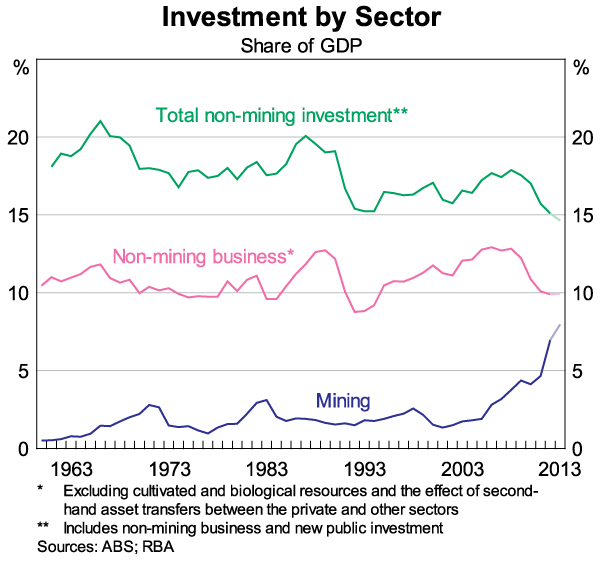
This weakness in investment outside the resources sector is widespread across industries. According to the most recently available Australian Bureau of Statistics (ABS) data, in 16 of the 18 individual non-mining industries, the level of investment (relative to GDP) is at, or below, the average level of investment for the years from 2005 to 2008. The two exceptions are the utilities sector, where there has been significant private investment in electricity distribution and water supply, and agriculture, which has benefited from high global food prices.
The low level of overall non-mining investment has occurred despite corporate balance sheets being in generally sound shape and firms having significant holdings of liquid assets. It has occurred despite financial institutions reporting that they are willing and able to lend. And it has occurred despite lending rates being at record lows for both large and small businesses (Graph 4).
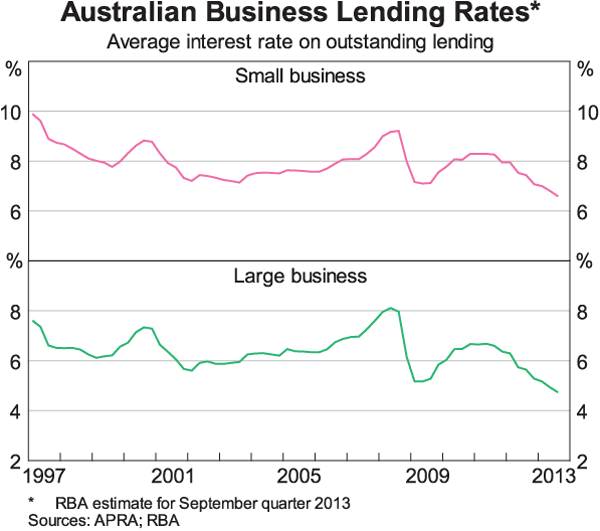
So the obvious question is: why is this happening? As usual, there is no single answer, but I would like to highlight four factors.
The first is a technical point, but a relevant one nevertheless.
The investment figures I have quoted are for nominal investment relative to nominal GDP. Most of the time, this provides a reasonable guide as to what is going on. But over recent years, the price of capital equipment has fallen markedly, partly due to the appreciation of the exchange rate, which has reduced the price of imported goods. The lower prices mean that for a given amount of capital spending, the economy obtains more units of capital. As a result, while total non-mining investment as a share of GDP is lower than it was in the recession of the early 1990s, the non-mining capital stock is increasing a little more quickly than it was at that time. In a sense, we are getting more bang for our buck.
The second, and ultimately more important factor, is the exchange rate.
As I have talked about on previous occasions, Australia's floating exchange rate regime has played an important role in stabilising the Australian economy.[1] The appreciation of the Australian dollar since the mid 2000s is perhaps the single most important reason why the Australian economy has digested a boom in mining investment without overheating and without developing the imbalances that typically accompany such booms.
That is the good news. But in playing this stabilising role, there is also a downside. The exchange rate appreciation has taken pressure off domestic capacity by making it cheaper for Australians to buy imported goods and by reducing the competitiveness of firms in export markets. In so doing, it has reduced the return on capital in those traded sectors that are not benefiting from high commodity prices, and thus reduced the incentive to invest. This is perhaps most obvious in the manufacturing and tourism sectors, where the level of investment, as a share of GDP, is very low by historical standards (Graph 5). Indeed, in these industries, the current rate of investment is at, or below, the depreciation of the existing capital stock. The low level of investment in the manufacturing sector is particularly noteworthy, as manufacturing has historically accounted for around one-fifth of total non-mining investment.
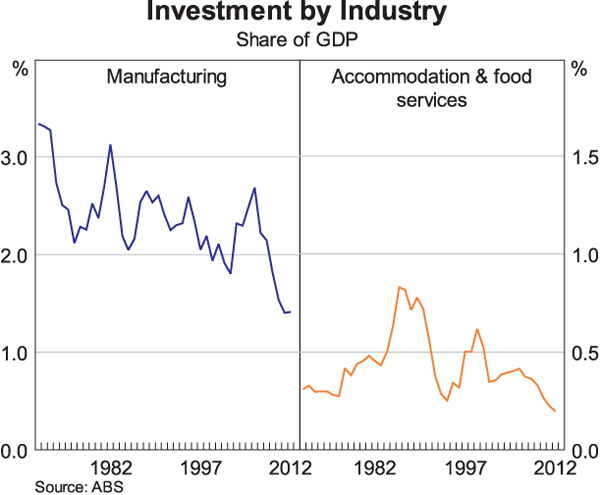
The third factor that I would like to discuss is the general lack of confidence by business. This lack of confidence can be seen in the various business surveys over recent years and has been clearly apparent through the Reserve Bank's regular program of meetings with firms across the country (Graph 6). This reported lack of confidence is consistent with firms being uncertain about the future and risk averse in their decision making.
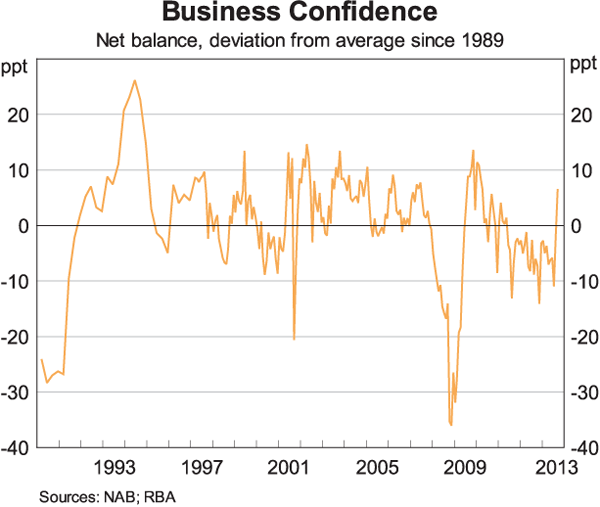
So the logical question here is: why has business confidence and the willingness to take risk been so subdued?
Again, there is no single answer. But many of the businesses that we have talked with over the past couple of years have cited the uncertainty associated with the structural changes in the economy, including as a result of the high exchange rate. They have also cited the political environment, particularly the previously hung parliament. And they have cited an increased regulatory burden. While we cannot be sure, it is likely that each of these factors has affected the willingness of some firms to expand. A common message from business has been that they thought it was worth waiting a while to see how things worked out before they made decisions that were costly to reverse. In the parlance of economists, the ‘option value’ of waiting has been high.
Beyond these Australian-specific factors, I suspect there is also a deeper global factor at work – and that is the legacy of the financial crisis. Recall that prior to the crisis, there was the Great Moderation. During that earlier period, the additional compensation that businesses required for taking a risk was quite small. Confidence was high and volatility was low. The financial crisis changed all this. It reminded us all that bad outcomes were possible. And since then, the frequent news about the problems in the euro area and the possibility of political stalemate preventing the US government from meeting its financial obligations have only served to reinforce this idea.
This scarring from the financial crisis is still with us and I suspect it will be with us for some time yet. It not only helps to explain why investment is weak outside the resources sector in Australia, but also why investment is very low in many advanced economies despite generally healthy corporate balance sheets, very low interest rates and large-scale quantitative easing by central banks.
While recently we have seen some return to risk taking in financial markets, potential owners of real capital in the developed economies have not yet been prepared to step forward in significant numbers and take a risk. Consumer demand has been soft and businesses have wanted to wait and to see what happens. They have felt more comfortable leaving their money in bank accounts earning very low rates of interest, rather than taking the chance and investing in new capital. This change in corporate attitudes is, I suspect, one of the enduring but underappreciated consequences of the financial crisis. At the aggregate level, the Australian economy has been shielded from its effects by developments in the resources sector, but some areas of the economy are clearly feeling the impact.
Finally, a fourth factor that has had an effect on the overall level of investment in Australia is the change in household spending behaviour. Unlike in earlier years, growth in household consumption is no longer running ahead of growth in household income. The step-down in the rate of growth of retail spending in particular has reduced pressure on capacity and affected rents for retail properties. There has also been some reassessment of the appropriate model of retailing. The result can be seen in the ABS's estimates of total investment in the retail industry which, as a share of GDP, is at the lowest level for many years (Graph 7). The ABS data also suggest that there has been some flow-on effects to investment in the wholesaling industry, which is also at quite a low level.
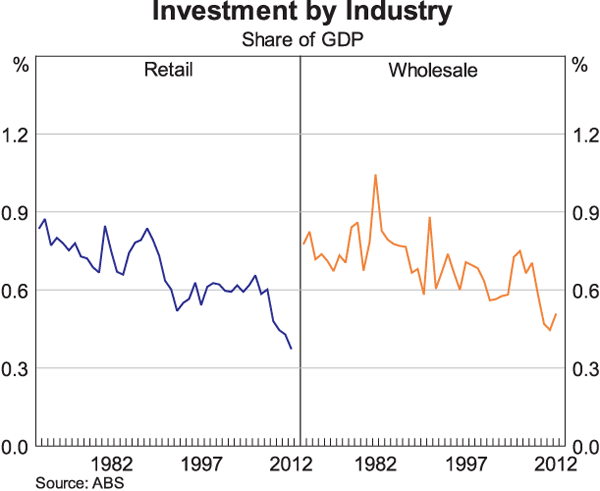
So, in summary, the high exchange rate, uncertainty, risk aversion and the changes in household spending behaviour have all weighed on non-mining investment over recent times. As a result, non-mining investment has made little contribution to growth in the overall economy (Graph 8). This is at a time when mining investment is no longer increasing, with the mining boom transitioning from one based on investment to one based on production. As best we can tell, mining investment declined over the past year, while net exports rose strongly due to lower capital imports and the higher production of bulk commodities made possible by the earlier investment.
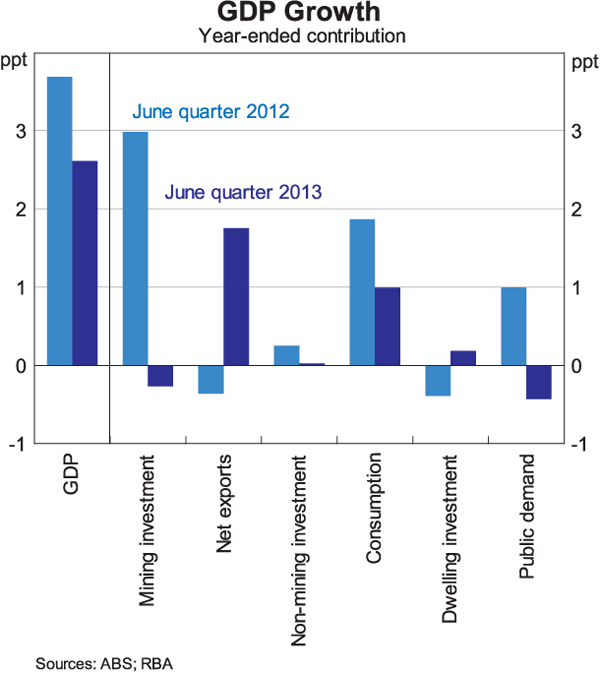
Looking Forward
So having looked back at what has happened so far, I would now like to look forward.
Over the period ahead, the level of mining investment is likely to decline substantially as existing projects are completed. The exact profile remains difficult to determine, but it would not be surprising if mining investment, relative to GDP, declined by 3 percentage points or more over coming years.
A decline of this magnitude should be manageable, just as the earlier rise was manageable. It will, however, require a further rebalancing of the economy. As part of this rebalancing, exports are set to grow strongly, particularly when the large LNG projects come on line. There will also be slower growth in imports of capital goods as projects are completed. But these adjustments on the trade side will not be enough, by themselves, to ensure that growth in output and employment is satisfactory. This means that other forms of spending will need to pick up.
One of these other forms of spending is residential construction, and the modest rise that is underway here is a welcome development. Some lift in consumption growth is also expected, although a return to consumption growth faster than income growth for an extended period is unlikely. It would also be unwelcome given the relatively high levels of existing household debt.
So this means that a pick-up in non-mining investment is an important part of the story in the return of the Australian economy to trend growth. Indeed, our expectation is that this will take place, with growth in non-mining investment predicted to pick up to at least high single-digit rates within the next couple of years.
This is, of course, a forecast and there is the usual wide range of uncertainties. These include uncertainty as to the appropriate steady-state capital-output ratio for the economy and the associated investment ratio. These important structural variables are influenced by a whole range of considerations, including the rate of total factor productivity growth, population growth, the rate of depreciation and the industry structure.
But from a more cyclical perspective, there are a number of factors that support the outlook for a steady pick-up in non-mining investment. The three factors I want to list – and they are clearly interrelated – are some depreciation of the exchange rate, an improvement in business confidence and the very low level of interest rates.
While the Australian dollar has appreciated over the past couple of months, on a trade-weighted basis, it is around 8 per cent lower than the peak in April this year. It is still too early to see the impact of this on investment, although the depreciation has improved prospects in some areas of the economy. In particular, there are parts of the tourism and manufacturing industries where the outlook is now a bit more positive, especially for firms that had earlier responded to the high exchange rate by doing whatever they could to make themselves more competitive. The more positive outlook in the tourism industry is also being supported by the steadily increasing number of visitors from China.
This depreciation of the Australian dollar since April is a welcome development, and a further depreciation would be helpful in rebalancing growth in the economy. Ultimately, floating exchange rates adjust to the relative returns on capital across countries. When investment in Australia was very high and rising, and investment elsewhere in the world was very weak and falling, it was not surprising that the Australian dollar was at quite a high level. This was a textbook response to an investment boom. But the textbook would also predict that as the mining investment boom in Australia unwinds and, hopefully, investment in the developed economies picks up, some realignment of the relative value of the Australian dollar would occur. This process has started, although it has been interrupted recently, partly due to the changed outlook for US monetary policy. Whether we will see a further realignment remains unclear, but, from today's perspective, a lower value of the Australian dollar would assist in lifting investment and activity in the sectors that have been constrained during the years of the mining investment boom.
The second factor on my list is an improvement in business confidence over recent months, which is evident in a graph that I showed earlier (Graph 6). This improvement is also apparent in our discussions with businesses, and there has also been a lift in consumer confidence. These are positive developments. Just as a lack of confidence about the economy can be self-fulfilling, so too can be a recovery in confidence. If businesses are prepared to spend, jobs tend to get created, incomes tend to rise and people see opportunities where previously they saw none.
So an important issue here is whether this improvement in confidence will be sustained. A fair amount depends upon international events. If global growth is in line with most forecasters' central outlook, it is quite possible that confidence, both overseas and in Australia, will be sustained at a higher level than it has been in recent times. There are, however, a range of things that could go wrong, with the latest wrangling over the US debt ceiling providing just the latest example of developments that damage confidence.
But beyond international events, domestic policy choices also matter. Business confidence – and thus the preparedness to take risk – is likely to be higher if the policy environment is predictable and there is strong commitment to ongoing reform to make markets work well and to boost productivity. Ensuring that regulation is fit for purpose is also important. So too is ensuring that the general business environment promotes innovation. These are all difficult areas to get right, but doing so is key to creating an environment where business is confident enough to take a risk, buy some new capital, hire a new worker or expand their operations.
The third factor on my list is the low level of interest rates. The impact of these low rates is evident across a range of indicators and it has further to run. In the housing market, prices and turnover have risen and, as I noted earlier, dwelling investment is increasing. There are also signs of an increased appetite for borrowing, most notably among those purchasing a property to rent out. More generally, households seem prepared to move out a little along the risk spectrum in an effort to increase their expected returns.
These developments are creating new business opportunities. So too is the steady growth in the Australian population, which remains considerably faster than in almost all other advanced countries; at the current pace of growth in five years' time, the population will be around 10 per cent higher than at present. When businesses are deciding today whether to take advantage of these opportunities, they face a low cost of borrowing and finance is available for sound projects. In time, this should underpin a rise in investment across a range of industries.
Of course, none of this is locked in. But, together, a lower value of the Australian dollar, an improvement in business confidence and low interest rates provide the basis for our outlook of a gradual lift in the non-mining economy over the next couple of years.
Thank you very much for listening and I look forward to your questions.
Endnotes
I would like to thank Gareth Spence and Leon Berkelmans for valuable assistance in the preparation of this talk. [*]
See Lowe P (2013), ‘Internal Balance, Structural Change and Monetary Policy’, Address to the Australian Industry Group 13th Annual Economics Forum, Sydney, 19 March. [1]